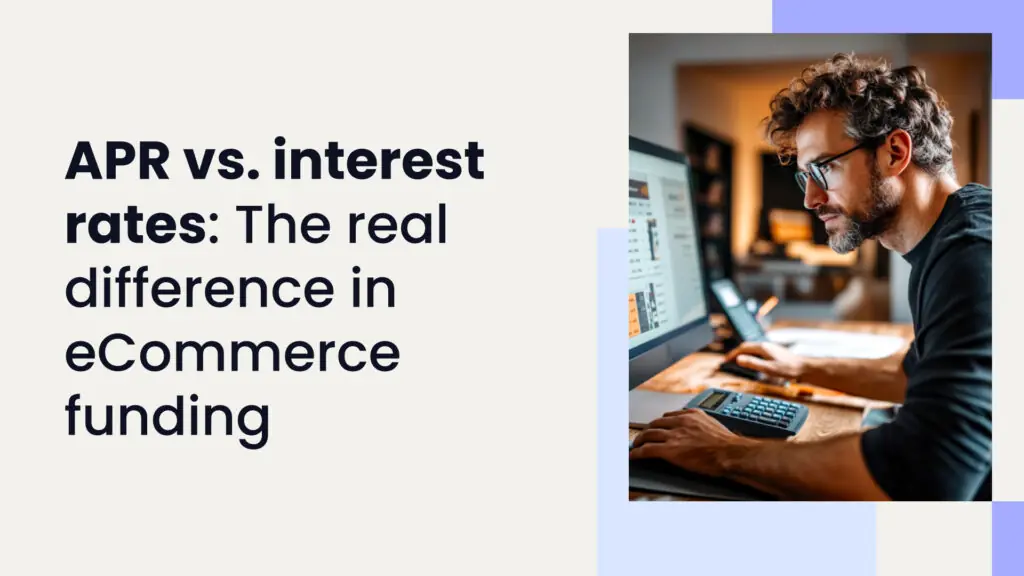- What is APR, and how does it differ from interest rate?
- How APR works
- APR vs interest rates vs APY: What are the main differences?
- Types of APR
- The importance of understanding APR for eCommerce loans
- What are the factors that affect your APR?
- How to choose the right eCommerce business loan
- Strategies for maximizing funding opportunities
- Takeaway: Understanding APR helps you make smarter funding decisions
At a current CAGR (compound annual growth rate) of 12.22%, the eCommerce sector is projected to reach $47.73 trillion by 2030.
Funding is a key contributor to this growth. However, getting the right funding with the best APR (annual percentage rate) is paramount to managing an effective eCommerce business.
What is APR, and how does it differ from interest rate?
APR is where many business owners get confused. Most companies are only familiar with the term ‘interest rate’ and can’t tell the difference between interest rates, APRs, and the overall cost of capital.
While interest rate is the price paid for borrowing money and doesn’t include any added fees, APR is the yearly rate of interest that an individual or business pays on its loan. APR considers the interest rate and additional charges of a credit offer.
Somewhere between interest rate and APR is the cost of capital, which is the estimated cost of a company’s funds paid to the investor, in this case, the granter.
In this post, we’ll explore how APR works, its impact on your business, and why it’s more important than interest rates when it comes to eCommerce funding.
How APR works
APR is a comprehensive measure that covers the interest rate on a loan and any related fees or additional costs. It provides a complete picture of how much you’ll pay over a loan term compared to just the interest rate alone.
It’s worth mentioning that APR only includes compulsory charges. It doesn’t consider your compound interest or cover fines for late payments, or exceeding your credit limit.
Subscribe to the eCommerce newsletter for
top industry insights
How APR is calculated
The APR calculation factors in the interest rate, loan origination fees, and any other costs spread over the life of the loan.
Unlike an interest rate, which only shows the cost of borrowing as a percentage of the loan, APR consists of all these extra costs, giving you a clearer idea of the total cost of capital. This is especially important in eCommerce funding, where managing cash flow is vital.
If this explanation of how APR works sounds a bit complex, we will simplify it in this section with an example and by taking it one step at a time:
To calculate a loan’s fixed APR, you need to consider the following:
- Interest rate
- Additional fees
- Loan amount (also called principal)
- Number of days the loan will last
Here is the annual percentage rate formula:
APR = ([interest + fees / loan amount) / number of days in loan term]) x 365 x 100
The first step in calculating APR is to know the interest amount. Use the following formula:
I = P x R x T
- I stands for Interest
- P stands for principal (loan amount)
- R stands for interest rate converted from percent to decimal
- T stands for the time period
To calculate APR, use the following steps:
- Calculate the simple interest rate as shown above
- Add the administrative fees
- Divide by principal
- Divide by the total number of days in the loan term
- Multiply the result by 365
- Multiply by 100 to convert to a percentage
Here is an example:
If an online store takes out a $50,000 loan to expand its product line, the loan comes with $1,250 in fees and a 5% interest rate for five years.
APR = ([interest + fees / loan amount) / number of days in loan term]) x 365 x 100
Use the simple interest formula:
I = P x R x T
In this case:
- P = $50,000
- R = 5% (5 x 100 = .05)
- T = 5 (loan term in years)
Therefore, I = 50,000 x 0.05 x 5 = 12,500.
Now that we know the interest, we can use the formula to determine the online store’s APR.
APR = ([interest + fees / loan amount) / number of days in loan term]) x 365 x 100
APR = ((12,500 + 1250/50,000)/ 1,825 )) x 365 x 100 = 5.5%
The APR on this loan is just over 5%.
From the APR calculations, you can see that even though the interest rate on this loan appears to be 5%, the actual annual cost is 5.5% when all the charges are included.
When you know the APR on your credit card, you can use it to calculate how much you may have to pay on your loan.
APR vs interest rates vs APY: What are the main differences?
APR , interest rates, and APY (annual percentage yield) are all terms used to describe the cost of borrowing or the return on an investment. However, they have distinct meanings.
As discussed, your APR is your annual percentage rate, but it doesn’t consider your compound interest. Conversely, the interest rate is the percentage a lender charges on your business loan principal (the money you’ve borrowed). This percentage is only a part of your APR.
The other parts of the APR consists of the fees the lender charges when you take the loan. Those fees get stacked together with the interest amount, and you pay both down simultaneously, in installments.
Popular content
- 14 strategies to improve your eCommerce business’s financial health
- 50+ ChatGPT prompts to elevate your eCommerce business
- A guide to pricing your product on Amazon
- 5 marketing metrics all eCommerce businesses should track
- All about Amazon PPC
Some may confuse APR with APY, but APY considers the compounding of interest, which APR doesn’t. Investments like savings accounts use APY calculation to show how much you earn rather than how much you pay.
| Aspect | APR | Interest rates | APY |
|---|---|---|---|
| Definition | The total cost of borrowing money, including both interest and fees. It is calculated using simple interest and expressed as an annual rate. | The percentage charged by lenders for borrowing money, not including fees. | The effective annual return on an investment or loan, considering compounding. |
| Fees | APR includes both interest and additional fees (e.g. origination fees). | Interest rate only accounts for the cost of borrowing. | Focuses on compounding interest earned or paid. |
| Used for | Typically used for loans (e.g. mortgages, credit cards) to reflect the overall cost of borrowing. | Used for determining the base interest cost on loans or savings. | Commonly used for savings accounts, CDs, and loans where compounding interest applies. |
Types of APR
There are various types of APR that eCommerce sellers should be aware of when securing funding:
Fixed-rate
A fixed APR is established on a fixed percentage set by the funder. It does not wave in response to any external factors. Every month, you pay the same interest on your debt.
Variable rate
Conversely, variable-rate APRs are linked to an index, which means that they can change month to month based on external factors.
In the United States, variable APRs are often linked to the prime rate index, which means that if the prime interest rate increases, so does the APR.
The prime rate index is set to match the Federal Reserve’s EFFR (effective federal funds rate). Therefore, whenever the federal government modifies interest rates across the country, the variable APRs will be modified accordingly.
In our earlier example, the 5% annual percentage rate was fixed. That means that the APR remained constant throughout the loan’s term. This offers predictability, allowing eCommerce businesses to plan their cash flow and loan repayments without worrying about fluctuating costs.
Nevertheless, APRs can change. In this case, it means the APR on the loan is variable and changes based on market conditions. If the APR on a loan is going to change, the lender is required to give advance notice to the borrower explaining why there is a change.
Knowing which type (fixed or variable) of loan you’re getting is important when requesting one because it will affect your monthly payments.
The importance of understanding APR for eCommerce loans
Since most US businesses rely on some form of credit, accurately assessing eCommerce loan costs is vital for maintaining healthy cash flow and avoiding unexpected financial burdens.
Knowing your APR is critical because it’s the price you pay to borrow money. When you are aware of the price you have to pay to take an eCommerce loan, you can better compare funding options to get the best deal for your business.
Generally, you should avoid debt with high APRs because the cost could overwhelm your budget.
What are the factors that affect your APR?
Several factors can affect your APR, determining how much you eventually pay. Here are the most important ones:
- Your personal credit score: A lender will consider your business and creditworthiness to determine whether you qualify for a loan and the set APR.
- Type of loan: The type of business loan you get will impact the interest rate you receive. Bank loans typically range between 5-15%, whereas alternative lenders offer higher rates.
- National interest rates: The Federal Reserve sets the national interest rates, which may also impact the interest rate you may get on a loan.
- Business history: If your eCommerce business is new, your interest rate will most likely be higher. This is because lenders see your business as a high risk compared to more established ones.
- Financials: A healthy balance sheet with stable and reliable cash flow will increase the likelihood of a lender offering a reduced interest rate.
- Collateral: You could get a lower rate if you pledge any collateral for the loan, such as business equipment or inventory.
| Factor | Description |
|---|---|
| Personal credit score | Lenders evaluate both your business and personal creditworthiness to determine eligibility and the APR you receive. |
| Type of loan | Different loan types impact your interest rate. Bank loans typically range from 5-15%, while alternative lenders may offer higher rates. |
| National interest rates | Set by the Federal Reserve, national interest rates influence the rates you may receive on your business loan. |
| Business history | New eCommerce businesses often face higher interest rates, as lenders consider them riskier compared to established businesses. |
| Financials | A stable balance sheet and reliable cash flow improve your chances of securing a lower APR from lenders. |
| Collateral | Offering collateral, such as equipment or inventory, can help you qualify for a lower interest rate. |
How to choose the right eCommerce business loan
There is no one best option for eCommerce business loans. Finding the right loan provider depends on how much money you want to borrow, how quickly you want it, and how you compare APRs.
Of course, we assume the first two considerations are already settled for you at this point, so we will focus on comparing APR.
When comparing APRs, in addition to interest rates, evaluate fees and ensure the repayment schedule aligns with your cash flow cycles. This is important, especially if your sales are seasonal.
Finally, consider term length in your decision-making. Longer-term loans might have higher APRs but offer lower monthly payments, which could help with short-term cash flow.
That being said, before taking a loan, assess your eCommerce company’s financial health. If you don’t know where you stand, tools like 8fig’s financial dashboard can help you see the full details of your inflow, profits, and expenses so you can make a better decision about borrowing.
Might also interest you:
- The ultimate step-by-step guide to eCommerce seller financing
- eCommerce funding: which option is right for you?
- What US interest rate cuts mean for your eCommerce business
Strategies for maximizing funding opportunities
To maximize your funding opportunities and hopefully minimize your APR, here are four viable strategies:
Improve your credit score
Lenders consider both business and personal credit history to determine the risk level for each borrower. They review personal credit history as an indicator of how well you manage and repay debts.
Maintaining a higher credit score can significantly lower your APR and increase your odds of securing funding.
Increase your eCommerce sales
Lenders want to see that your eCommerce business has an overall positive inflow that is high enough to allow you to make repayments without a problem.
To present yourself in the best light possible, it’s essential to clearly understand these numbers before applying for a loan. If you have an excellent positive inflow and more stable revenue, they will likely offer you a lower APR.
Know your metrics
As an eCommerce business, take note of your KPIs. Potential lenders will most likely focus on these metrics in addition to sales. They will examine metrics like customer acquisition cost (CAC), customer lifetime value (CLV), and conversion rates.
They expect a low CAC and a healthy CLV for the eCommerce business to be seen as an appealing investment option.
Diversify funding sources
While getting a bank loan or money from a venture capitalist (VC) remains popular, you should explore alternative funding sources. Angel investors, crowdfunding platforms, eCommerce accelerators, and strategic partnerships can also inject capital into your eCommerce business.
Negotiate terms
Don’t be afraid to negotiate APR and fees, especially if your business is performing well.
Takeaway: Understanding APR helps you make smarter funding decisions
From all we have discussed above, understanding APR is critical for eCommerce loans because it helps you understand the total cost of the loan, therefore leading you to make smarter decisions based on your specific business needs.
Understanding the total cost of a loan is vital for scaling business operations, managing cash flow, and overall financial health – but focusing solely on interest rates can be misleading.
APR essentially offers a broader picture of your total borrowing costs. When searching for eCommerce funding, you can use the information in this article to compare the APRs of different funding options and select the one that best suits your business needs.
While APR and funding is crucial, we believe that it’s not the most important part – what’s truly imperative is to find a funding company that not only provides the funds, but also helps you understand how to navigate it according to your specific, changing needs. The goal of flexible, adjustable, eCommerce-specific funding is to help you plan for long-term success, instead of just giving you the money to fend for yourself. We encourage you to find companies that don’t just offer funds, but ones that are there provide the right tools to scale and maintain those profits.
Remember, it’s not just how much funding you receive – it’s what you do with that funding. Get your offer from 8fig today to experience and maintain growth over time.
Have article ideas, requests, or collaboration proposals? Reach out to us at editor@8fig.co – we’d love to hear from you.
- What US interest rate cuts mean for your eCommerce business
- The ultimate 2024-2025 holiday season calendar for eCommerce sellers
- The ultimate step-by-step guide to eCommerce seller financing
- Behind the scenes: The creative process at Ugly Wolf and the power of personal branding
- How to optimize your supply chain for the holiday season
Subscribe to the eCommerce newsletter for
top industry insights
to our blog
Read the latest
from 8fig

Overhead costs quietly eat into your margins – unless you know how to outsmart them. These four strategies will help you cut the fat and grow leaner, faster.

Selling more doesn’t mean that you have to be pushy. Learn how to upsell the smart way, with real eCommerce examples.

Amazon’s Big Spring Sale starts March 25 – here are 9 quick tips to help sellers prep, boost visibility, and stay competitive through the rush.
